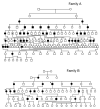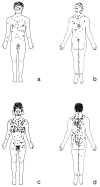Tumor mapping in 2 large multigenerational families with CYLD mutations: implications for disease management and tumor induction
- PMID: 19917957
- PMCID: PMC2935681
- DOI: 10.1001/archdermatol.2009.262
Tumor mapping in 2 large multigenerational families with CYLD mutations: implications for disease management and tumor induction
Abstract
Objectives: To comprehensively ascertain the extent and severity of clinical features in affected individuals from 2 large families with proven heterozygous mutations in the CYLD locus and to correlate these findings with the 3 appendageal tumor predisposition syndromes (familial cylindromatosis, Brooke-Spiegler syndrome, and multiple familial trichoepitheliomas) known to be associated with such germline mutations.
Design: Interfamilial and intrafamilial observational study.
Setting: Tertiary genetic and dermatology referral center.
Participants: Thirty-four individuals recruited from 2 large multigenerational families with CYLD mutations. Clinical details, history, and tumor maps were obtained from all participants; in 18, the information was corroborated by detailed clinical examination.
Main outcome measures: Tumor density, distribution and histologic findings, associated medical conditions, patient symptoms, and impact of disease on quality of life.
Results: The severity of penetrance and phenotype varied within families. Although an approximately equal female to male predisposition was noted, 5 women and 1 man (of 26 patients surveyed [23%]) had undergone total scalp removal. The average age at onset was 16 years (range, 8-30 years). Symptoms reported by affected patients included painful tumors (in 12 of 23 patients [52%] who answered the question), conductive deafness, and sexual dysfunction. Of the 26 surveyed patients, tumors were noted on the scalp in 21 (81%), on the trunk in 18 (69%), and in the pubic area in 11 (42%). Tumor mapping provided clinical evidence that correlated with hormonally stimulated hair follicles being particularly vulnerable to loss of heterozygosity and tumor induction.
Conclusions: The burden of disease at sites other than the head and neck appears to be underreported in the literature and greatly affects quality of life. Differentiation between the clinical diagnoses has little prognostic or clinical utility in genetic counseling, even within individuals from the same family. Thus, we suggest an encompassing diagnosis of "CYLD cutaneous syndrome." Finally, the clinical distribution of tumors suggests that hormonal factors may play an important role in tumor induction in these patients.
Figures




References
-
- Young AL, Kellermayer R, Szigeti R, Teszas A, Azmi S, Celebi JT. CYLD mutations underlie Brooke-Spiegler, familial cylindromatosis, and multiple familial trichoepithelioma syndromes. Clin Genet. 2006 Sep;70(3):246–249. - PubMed
-
- Saggar S, Chernoff KA, Lodha S, et al. CYLD Mutations in Familial Skin Appendage Tumors. J Med Genet. 2008 Jan 30; - PubMed
-
- Bignell GR, Warren W, Seal S, et al. Identification of the familial cylindromatosis tumour-suppressor gene. Nat Genet. 2000 Jun;25(2):160–165. - PubMed
-
- Evans CD. Turban tumour. Br J Dermatol. 1954 Dec;66(12):434–443. - PubMed
-
- Jahoda C, Reynolds A. Skin stem cells - a hairy issue. Nature medicine. 2000 Oct;6(10):1095–1097. - PubMed
Publication types
MeSH terms
Substances
Grants and funding
LinkOut - more resources
Full Text Sources
Medical

